- Protestors kneeling during Nemec’s speech. Photo taken by Kyler Erezuma.
- Protestors enter the “Community in Action Event.” Photo Taken by Kyler Erezuma.
- Students holding flag up in front of President Nemec during his speech. Photo taken by Alejandro Serrano.
- Students kneeling during Nemec’s speech. Photo taken by Kyler Erezuma.
- A Community in Action: Sharing Our Work in and Commitment to Diversity and Inclusive Excellence event was held on Monday, Feb. 28 in the Event Hall at the Charles F. Dolan School of Business. At the event, student and faculty protestors arrived right before University President Mark Nemec, Ph.D spoke. After Nemec finished speaking, protestors left. Photo Taken by Kyler Erezuma.
- The Fairfield U Community that was present at the “Community in Action” Event. Photo Taken by Kyler Erezuma.
- Protestors held up flags during Nemec’s speech. Taken by Kyler Erezuma.
- Student held up “People for others means Black People” sign in reference to the Jesuit mission, “People for Others.” Photo taken by Kyler Erezuma.
- Black Lives Matter flag held up by protestors. Photo taken by Kyler Erezuma.
- Protestors holding “Black Lives Matter” flags in front of President Nemec during his speech. Photo Taken by Kyler Erezuma.
- Students holding up “Black Lives Matter” flag during President Nemec’s speech. Photo taken by Alejandro Serrano.
- Students kneeling during President Nemec’s speech. Photo taken by Alejandro Serrano.
- Students kneeling during President Nemec’s speech. Photo taken by Kyler Erezuma.
At 3:39 p.m., just minutes before President Mark R. Nemec Ph.D. was set to talk for the “A Community in Action: Sharing Our Work In and Commitment to Diversity and Inclusive Excellence” event, over 100 student and faculty protestors entered. Protestors wore black, had various Black Lives Matter buttons and carried signs declaring, “Black Lives Matter,” “#NoMoreNeutrality” and “People for Others Includes Black People,” a reference to the Jesuit value of “Men and Women for Others.”
The event took place on Monday, Feb. 28 from 3:30- 5:00 p.m. in the Charles F. Dolan School of Business Event Hall and came just about a week after The Mirror broke the news that University administration directed the removal of a Black Lives Matter flag from the front window of Counseling & Psychological Services.
The first person to speak — Jocelyn M. Boryczka, Ph.D., associate vice provost for scholarly, creative and community engagement opened the event stating that “We have come together today as we have done in the past, to advance our work for racial and social justice.”
Boryczka continued to invite members of the event, to “recognize the pain that some members of our community may experience, however unintended it may be, and the need for healing and reconciliation.”
She further asked, “…that we embrace a spirit of forgiveness.”
After her introduction, she handed off the stage to Rev. Paul Rourke, S.J. who is vice president for mission & ministry at the University. Rourke offered a blessing. After this blessing, Boryczka introduced Nemec who was the keynote speaker of the event.
As Nemec began speaking, all protestors took a knee around the room. Some of the protestors then proceeded to hold up Black Lives Matter flags in front of the speaking podium while Nemec was talking.
Nemec began by emphasizing that the event “…is meant to be a celebration and, at large, it’s a journey.”
He continued to highlight his past with this work, as “This discussion is actually framed, as all discussions are, by any academic, by our personal narrative.”
“Since my senior year of high school, when I wrote an essay for our high schools Journal of Opinion defending the California system and affirmative action,” he states, adding that “It continued until 1997 when I wrote an essay for the Review of Higher education, on the role of curriculum in the University, and probably had its fullest formation in my book, Ivory Towers and Nationalists Mind.”
“Now, this is not meant to be a bibliography,” Nemec adds, “But what it is to signal and what it is to stress is that these are issues that require depth. These are issues that require inquiry, not simply instances.”
He states that this is what needs to be kept in mind when discussing the removal of the Black Lives Matter flag from the Counseling and Psychological Office, as reported by The Mirror last week.
He first goes over some “factual points” over the removal.
“First, staff were asked and acceded to the requests to remove the banner due to policies related to building code and public spaces,” Nemec states, “But more importantly due to our principles of free expression wholly irrespective of the content of that banner.”
He continues that Fairfield’s principles on freedom of expression were motivated, “…by the public targeting, through social media, of a faculty member for sharing research and analysis on race” and two documents, “The Stone Report” and “The Kalven Report.”
Nemec quotes specifically from the “Kalven Report” stating “…that the instrument of dissent and criticism is the individual faculty member or the individual students.”
“As we see today,” Nemec states in reference to the protestors, “The university is home and sponsor of critics, it is not itself the critic.”
He adds that “Neutrality of university as an institution arises then, not from a lack of courage, nor out of indifference or insensitivity, it arises out of respect for free inquiry and the obligation to cherish a diversity of viewpoints.”
“As a Jesuit Catholic institution, we are committed to economic, social, and racial justice” Nemec says, adding that this “…path to justice must be a subject of deep inquiry and discussion amongst individuals from all across our campus. As a Jesuit Catholic University, our discussion welcomes socialist capitalists, distributed libertarians, anti-racist and anti-anti racist perspectives, and all points across the spectrum characterized by rigor and intellectual honesty.”
He continues that he would like to “further clarify the record and reiterate, yet again, that the issue for the health center banner was its conflict with the spirit of institutional neutrality.”
Nemec adds that a contrast to this situation would be his support of a group of student-athletes wearing “statements on their jerseys” to the Metro Atlantic Athletic Conference that he “fully supported” and “received significant criticism” for, as the chair of the MAAC diversity and gender committee.
Nemec then shifts to highlight the Diversity & Inclusion Excellence Narrative that is the “launching point” for the University’s mission, holding up a printed copy.
The “Diversity & Inclusive Excellence Narrative” was created through, “a process of campuswide engagement…a leadership survey, Board of Trustees presentations and listening sessions with community members across campus” and driven by the University’s Presidential Working Group on Inclusive Excellence.
The introduction of the narrative first highlights its mission statement. Stating, “Members of the Fairfield University community are committed to respecting and valuing one another, finding the common good rooted in us all, and working collaboratively to achieve our potential as a modern Jesuit Catholic institution.”
It continues that they “…aspire to be an inclusive, welcoming community that is representative of an ever-changing and diverse global populace” and that Cura Personalis, the Jesuit value of “care for the whole person” supports their mission.
“We educate men and women who serve for and with others within the rich tapestry of cultures that comprise our contemporary world,” the statement continues, ending with, “By encouraging dialogue, communication, community partnerships, and a culture of understanding, we foster in our students, faculty, and staff the capacity and desire to build a better world through productive citizenship and societal stewardship.”
The narrative then diverges into three chapters: “Where We Have Been – Remembering”, “Where Are Now – Welcoming”, “Where We Want To Go – Belonging.”
The “Where We Have Been” section highlights the University’s past, highlighting certain significant moments in Fairfield’s history, “focused on religion, race, and gender” that opens a window onto Fairfield’s recent past.
The narrative then moves to Chapter Two, “Where We Are Now” discussing the “…current terrain of diversity and inclusive excellence at Fairfield University with an eye on our achievements and towards areas in need of attention.”
“We do so in the midst of a nation reckoning with its past as manifest in a present marked by a resurgent concern for social, cultural, economic, and political inequities faced by Black American communities in our nation, contentious border politics, and a polarized polity,” it reads, continuing that, “In particular, our current moment calls us to recognize race as a historically important issue, often focusing national conversation.”
In this section, the narrative also states that “Fairfield University approaches diversity with an intentionality of inclusion that provides the groundwork for our curricular, co-curricular, and community-oriented initiatives.”
They state that their work under the “Inclusive Excellence” category includes the introduction of a “Black Lives Matter” course that emerged after Fairfield students, faculty and staff formed the Racial Justice is Social Justice group, “in the wake of Michael Brown’s shooting by a police officer in Ferguson, Missouri on August 9, 2014.” They would then lead a die-in protest in the DiMenna-Nyselius Library’s lobby that was attended by then-Fairfield President Father Jeffrey von Arx S.J.
In The Mirror at the time of the protest, von Arx stated, “I’m here to support our students who are in solidarity with their peers and friends across the country. Fairfield has always stood for inclusiveness, and we want to make sure that as a Jesuit, Catholic university we have a welcoming atmosphere from all of our students. So I’m here to support this and I look forward to seeing the dialogue with these students about the issues they’re concerned with.”
In the “Inclusive Excellence” section, the narrative continues to discuss more educational and community opportunities students have, including community engagement opportunities and certain interdisciplinary programs.
Fairfield’s narrative then moves to discuss the second segment, “A Diverse Community” striving “…to welcome individuals from the fullest range of social, economic, racial, cultural, national, and religious backgrounds possible.”
It continues, “Building our diverse community begins with recruiting students, staff, administrators, trustees, and faculty to join us at Fairfield University, and then supporting them in their personal and professional development to meet an ever-changing world — and our students — continually where they are.”
The third aspect of the narrative is, “Global Engagement” and is supposed to convey the University’s commitment to “…preparing our students to become global citizens at home in the world, able to engage in different cultural contexts with an open mind and capacity to empathize with the perspectives of diverse peoples.”
The narrative then moves on to the third and final chapter, “Where We Want to Go” stating that, “Looking to the future, Fairfield aspires to ensure that all members of our campus community feel that they belong at Fairfield and consider it to be their home.”
The narrative ends by stating that, “We aspire to accompany our students and by extension, young people everywhere, in their efforts to build a shared human society that respects the dignity of all people and is enriched by diversity.”
The entire narrative can be found on the University’s website under their Mission, Values & History section.
After highlighting the printed narrative, Nemec then moved on to discuss his personal connection to the question of access and affordability.
“For me, this is again, a very personal journey” Nemec adds, “I think many of you know I was fortunate enough to grow up in Southern California in the 1970s and ‘80s, which was a particularly unique and notable time.”
Nemec adds that the Los Angeles Unified School District created a 40,000 square-mile district in order to create magnet schools to diversify the district, and his family committed him to attend for four years.
“Reflecting upon this with my mother recently, I really asked ‘Why did you put me on a bus to go an hour and 20 minutes each way,’” continues Nemec.
Nemec states that firstly, the curriculum of the school was “top notch.”
“But secondly, animated by our Catholic faith and values, was the thought that there is nothing more important for the dignity of every individual than advancing themselves through education.”
He continues that “It’s with that spirit in mind that it would call all of you to engage, as I have, in this effort for access and affordability”
Nemec adds that there is still work to be done looking at the statistics, as the University is “78% white, 22% other, including biracial, including those students who identify as Black, Hispanic, Asian, and alike.”
“Notably, this number has not moved in the last six years,” he continues, “Interestingly, though, one of the benefits of growth, is the fact that while the percentages remain the same, we have gone from having 853 students who identify as non-white to over 1,000 students who identify as non-white.”
“Is that enough? Of course not.” he adds, “Our ambient environment, our country, is so much more diverse, and we must be so as well.”
After mentioning the initiatives the University has taken to work towards diversity and inclusive excellence, Nemec goes on to address that there has been a “problem of the pool of available students of color and first-generation students, especially in the northeast, is dropping precipitously.”
Nemec relays that current data from the Common Application points out that students of color, specifically black males, dropped by 15% in terms of those who are applying to college in 2021.
He continues that the new mission is to bring more students to the Fairfield Community, and that the way the University is tackling this problem is through “Bellarmine College.”
“And I have to confess, as a classical liberal that is the way I frame this challenge,” Nemec says, finishing that, “For me, the question we have in front of us is not what we’re going to say. It is rather, are we going to roll up our sleeves and do the work as contemplatives in action? I have committed this institution to do so. And hopefully this event allows you the occasion to engage as well.”
Immediately following the end of Nemec’s speech, all student protestors stood up and exited the room before Vice President for Student Life Karen Donoghue closed the event’s speaking portion.
She stated, “This work is challenging, this work is hard. You will never get it right, which is why we are committed to this work.”
Vice President of Marketing and Communication Jenn Anderson said in a statement to The Mirror after the event, “Fairfield University encourages our students to express their views and opinions and fully supports their rights to free expression.”
She continued that today’s event was “…an opportunity for the University community as a whole to engage with our University’s history and commitment to diversity and inclusive excellence, and to review and discover a narrative that will work as a framework for the University’s continued efforts.”
Anderson continues that the University welcomes students to “express themselves with a spirit of humility, inquiry, generosity of spirit and intellectual honesty and rigor” and encourages “…our community to engage in the important work we are embarking on around Diversity, Inclusion, Access and Affordability.”
“As President Nemec stressed in his remarks, the University must maintain an environment that is conducive to open dialogue and freedom of expression for our faculty, students and staff,” Anderson stated, mentioning the Kalven Report and Nemec’s quote of it that, “…the instrument of dissent and criticism is the individual faculty member or the individual student. The University is home and sponsor of critics; it is not itself the critic.”
She finished by stating, “The neutrality of the University as an institution arises then not from a lack of courage nor out of indifference and insensitivity, it arises out of respect for free inquiry and the obligation to cherish a diversity of viewpoints.”
After the event, many students provided comments regarding the “Community in Action” event, including those that organized the protest against the event.
Senior Tushi Patel, senior resident assistant, and one of the main organizers of the protest stated that a good friend and mentor encouraged her to take her anger at the removal of the Black Lives Matter flag from C&PS and channel it, and she did so, through organizing.
She continued that, “Throughout my life, I’ve learnt the lesson that if you want something, you must do it yourself, whether that is academic success, experiences, whatever it may be. However, in the past few years I’ve added the insight that sometimes you must lean on others to achieve that goal.”
Patel continued that initially she considered a dialogue, but decided “now was the time for action.”
“If not now, then when?” Patel adds, continuing, “It’s my last semester at Fairfield University, and I wasn’t entirely surprised by the request to remove the BLM flag, but I was tired. I was tired of the lack of support. I was tired of the neutral stance consistently taken. I was tired of consistently discussing and not seeing anything being done. So, we did it.”
Senior Ruby Francis, president of Gender & Sexuality Alliance and College Democrats, added that she is both proud of all of those who participated in the protest and grateful for Patel for “taking the initiative to start organizing.”
“I am once again extremely disappointed, but not surprised by what was shared by University admin during Monday’s event,” Francis continues.
Francis stated that as the president of GSA, “I want to note the importance of intersectionality. When we say Black Lives Matter, we mean that Black gay lives matter, Black transgender lives matter, Black disabled lives matter and so on. The genuine support of Black students on our campus is crucial and this diversity narrative changes nothing.”
Francis moved on to discuss the University’s stance on neutrality. Adding that, “Neutrality here means that he and other admin are taking the side of the oppressor.”
“Further, Nemec stated that the University is welcoming of various beliefs, and included what he called ‘anti anti-racism,’” Francis added, continuing, “It is clear here that he means racism and therefore is perfectly fine with racism on campus. The tone of his speech, especially while discussing the BLM flag, seemed very aggressive, and was the same while addressing those who were protesting.”
Senior Emily Marshall also discussed the “aggression” in Nemec’s speech.
“It was disgusting and disappointing to not have to digest what was being said throughout the duration of the event speeches but especially the tone and aggression coming from Nemec” Marshall added, continuing, “In trying to advocate for a movement that addresses social injustice, human rights and public health and pushing our Jesuit Institution to also be in support it was not the response needed or necessary.”
Sophomore Kayla Medina stated that she spent the morning after the event rewatching clips of Nemec’s speech and that she found herself “more and more disgusted with each clip.”
“To hear him openly state that ‘our discussion welcomes…anti-racist and anti-anti-racist perspectives’ at Fairfield makes me truly embarrassed to be a student here. Anti-anti-racist is the equivalent of racist” Medina stated, continuing, “Our so-called leader of the University, at an event meant to share Fairfield’s ‘Work In and Commitment to Diversity and Inclusive Excellence’, literally stated that racist perspectives are not only tolerated but WELCOMED. Where do you go from there? How is this school ever going to change when these dangerous, bigoted statements come from the top?”
Sophomore Donna Ismail added that they were frustrated by the administration’s lack of reaction to the protestors at the event, stating, “Nemec stood in front of 5 Black Lives Matter flags and did not acknowledge us or the movement once!”
Junior Ray Hinds stated that they wanted to firstly thank all the students that participated in both the “blackout” and the protest.
The “blackout” Hinds is referring to was held the day of the “Community in Action” event, where the Fairfield University Community was asked to “wear black to show your solidarity to the Black Community on campus.”
“To our administration, DO BETTER!” Hinds continues, adding, “The students at Fairfield University have come together and used their voices to be heard and listened to, not ignored. Time and time again, the administration fails to address us as the population that we are, erasing our identities and invalidating our experiences. They continue to spread harmful ideologies of neutrality and silence when it is known for the fact that that is not what Jesuits stand for.”
Hinds also states that as a Jesuit university, a Jesuit leader is needed. “Although we cannot put the blame on one person,” they continue, “Nemec is one of our main leaders and he must feel our wrath for the actions he commits, knowing the damage it causes. It is time for a change in the higher administration, meaning a businessman/politician should not be our leader. Someone who understands the Jesuit values and how to apply them should be!”
Junior and Director of Diversity & Inclusion for the Fairfield University Student Association Eden Marchese agreed with Hinds’ statement, “Nemec’s speech proved that he is not fit to lead this University and that he is the coward and disgrace many have thought him to be behind closed doors. He is nothing more than another example of an old, white man who has benefited all his life from his privilege and is terrified at the notion of losing it. Instead of saying anything meaningful, he doubled down in racist rhetoric while yelling at the students he is supposed to support while attempting to manipulate them so that he can call himself the victim.”
In Oct. 2021, it was announced that Nemec’s contract was extended through the summer of 2027.
Sophomore Aliyah Seenauth, associate director of Diversity and Inclusion for FUSA stated that “After all that was said, though I was not shocked, I was once again disappointed.”
She continued that, “This could’ve been an opportunity for him to acknowledge his wrongs and commit to learning more and doing better, but instead his ego was higher than that. Him being aggressive as he was felt like the epitome of being mistreated by a white man as a person of color. Students needed to protest to gain the power and strength amidst everything going on. Regardless of all he said, we put our all into what we did. When we all kneeled, I felt tears in my eyes. I felt it was so unfortunate that we even had to do this, but there was something still so powerful about it. If he showed the slightest bit of empathy, maybe we would be more likely to respect him.”
“A part of me feels guilty for calling my peers into action into the silent protest because the speeches given, specifically Nemec’s, elevated a sense of toxicity and was traumatic. Personally, the words that were said are in a constant loop in my head and I am upset that we had to experience that,” Patel added.
She continued that the choice to utilize a silent protest was simply because “why not?”
“It was due time that we were seen,” Patel adds, “I feel that there have been conversations and that senior administration has heard concerns of ours, alums, and faculty/staff. And if they haven’t, then we have them. If you want to hear them, you know who we are. Reach out to us. Show us that you care. Show us that you are going to do something, not just give performative action. Start listening to the concerns and requests of your students. Because we’re not going to stop trying.”
Patel continues that, “Silence often speaks louder than words and we were hoping that our silence in that room would speak louder than our words would.”
Patel adds that, “But now I don’t think we can remain silent. Now it’s time that you hear our real voices, to hear a real narrative because the one that you are depicting is not representative of us. Our demonstration is not one that Nemec can take credit for. Nemec cannot say that a neutral stance allowed for this free expression. No, it didn’t. The neutral stance is only hurting our community. As for why he is the one that is being ‘pinned’ with all of this. It might have to do with his role as our university president. He manages to dictate many policies on this campus, i.e., the removal of the mask mandates and the community for the most part follows. What do you [Nemec] think saying Black Lives Matter would do? That we would lose donors? Isn’t it your job to work with them to support your community of students and faculty and staff? So, yes, I am unsurprisingly upset because I hadn’t expected to receive anything in our favor, still there were many things that were unexpected. And I’m sorry, even though it’s not for me to be apologetic, I still am to all those that showed up, that you also had to experience that because that was wrong and painful.”
Marchese continued by adding that the event itself was “…a perfect example of performative activism as the University used more marketing photos of students of color to push Nemec’s racist agenda. Not one of the speakers at the event actually spoke to the students there but tried to use the event as a way to congratulate themselves for the mediocre work they’ve done in creating an incomplete ‘narrative’ of Fairfield University.”
Marchese continued that though they cannot speak for the reasons of other students, “I know there is a general feeling of being tired of this institution. Too much of this University’s history is steeped in the pain of students, faculty, and staff of color and I think the activism around the removal of the BLM flag is just another example of the culture of racism that is lovingly fostered by Nemec and others.”
Marchese continues that though many members of FUSA worked to support and represent students during the event, “…I would be lying if I said I wasn’t disappointed in those that were notably absent and those who did not join in the protest while being at the event. FUSA speaks a lot about being leaders for the students though many members who preach this kind of idea failed to do anything other than sit in their ignorance and privilege.”
“This movement is one that students, faculty, and staff must do together,” Marchese adds, “While it is true that students have a lot of power on this campus, students have been in this battle alone for far too long and need more people to have the courage to speak out against those in positions of power.”
Many of the faculty then reacted to the student protest and the event in total.
Dr. Rachelle Brunn-Bevel, Ph.D., associate professor in the sociology department, Faculty Chair for Inclusive Excellence and member of the Presidential Working Group on Inclusive Excellence stated that “The release of the diversity and inclusive excellence narrative is a very important moment for the university and many people attending the event have been working very hard to make Fairfield a more equitable place.”
“However, many community members, including myself, were deeply troubled by the administration’s instruction to remove the Black Lives Matter flag,” Brunn-Bevel continued, “The student-led silent protest at today’s event was incredibly powerful and impactful. I have never been more proud of our students.”
Assistant Professor of Politics, Aaron Weinstein, Ph.D., stated that “I have never been more proud of the student body than I am today. In their solidarity, each and every student in attendance was doing exactly what Jesuit education calls for: they were acting as men and women for others. They listened and expressed themselves respectfully and thoughtfully at a time when that’s far from the norm. Their example was inspiring.”
Associate Professor of History and Co-Director of the Program in Latin American and Caribbean Studies, Jennifer Adair stated that, “Along with many faculty and staff, I was proud to support student actions protesting the removal of the BLM flag.”
Director of Humanitarian Action and Professor of Politics Janie Leatherman, Ph.D. stated that she participated in the “blackout” and posted a sign on her office to support Black Lives Matter.
“Those are small, symbolic gestures that I hope convey support,” Leatherman adds, continuing, “I am in solidarity with the cause of lifting up the lives of our students (faculty, administrators and staff, too) of color and honoring their human dignity and human rights that have been denied historically and are still violated and trampled today.”
Leatherman finished by saying that she believes that it is “… fundamental to the mission of a Jesuit university to stand against systems of oppression and express empathy for and seek ways to understand the perspectives, feelings and needs of those who are vulnerable and marginalized.”
“That seems indispensable to bring all the members of our community into an embrace that is inclusive. I am committed to that,” Leatherman said, continuing, “We need to be in dialogue to listen and learn from each other; and to take into account how policies and actions, such as removing the Black Lives Matter flag from the window of the Counseling and Psychological Services center, impacts especially students who already feel excluded. This is a painfully poignant example, not least as the mission of this office is to serve students in distress. I hope this experience alone utterly galvanizes us to come together to find new ways of becoming a more whole and truly welcoming community.”
Associate Professor of Marriage and Family Therapy, and Program Director of the Certificate in Sexuality and Gender Minority Mental Health, Erica Hartwell, Ph.D. stated that she was disappointed by Nemec’s remarks.
“It almost might have been better if he didn’t address the Black Lives Matter flag incident at all. His response was defensive, aggressive at times, and completely insensitive to the student experience,” Hartwell said, adding, “He did not address the students in the room with any kind of humanity or empathy. Never told them they were valued or welcome. He never acknowledged the emotional impact on them. In fact, he tried to gaslight them by saying that both he and the institution are, despite their own experience, on their side.”
Hartwell continued that Nemec seemed not to realize that the community’s response wasn’t just about the flag’s removal, “It is about a pattern of ignoring, excluding, and tokenizing students of color. It is about trying to address diversity through a handful of programs, some of which reek of saviorism. It is about not saying the words, black lives matter. It is about not providing the resources, structure, or leadership to create an inclusive and welcoming campus.”
“[Nemec] defended the low numbers of students of color by saying that fewer young black men are interested in college. And that we recruit with the intent to graduate. Both of these statements put the responsibility on the individual and whether they choose to come to Fairfield and whether they can graduate from Fairfield. What about our responsibility as an institution? Perhaps these young people are making the wise choice in not attending college, especially Fairfield, because these institutions were not built to serve them, they were built to exclude them. And if they cannot succeed at our institution, perhaps we need to examine our definition of success. Instead of looking at students as the problem, we need to look at ourselves,” Hartwell said.
Hartwell finishes by stating that, “The President emphasized institutional neutrality, which is a tool of white supremacy. Neutrality is inherently unequal in a society where some groups have more power than others. Furthermore, Jesuits are not neutral. Jesuits are people for others, they serve in the name of justice and love, and they find God in all things. How, then, does anti-anti-racism belong on a Jesuit campus?”

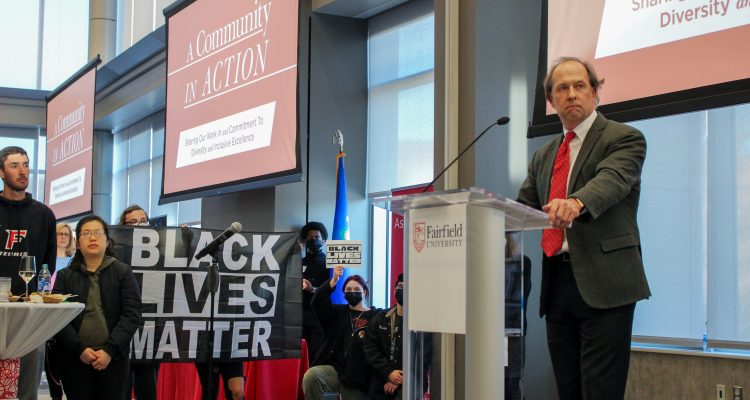
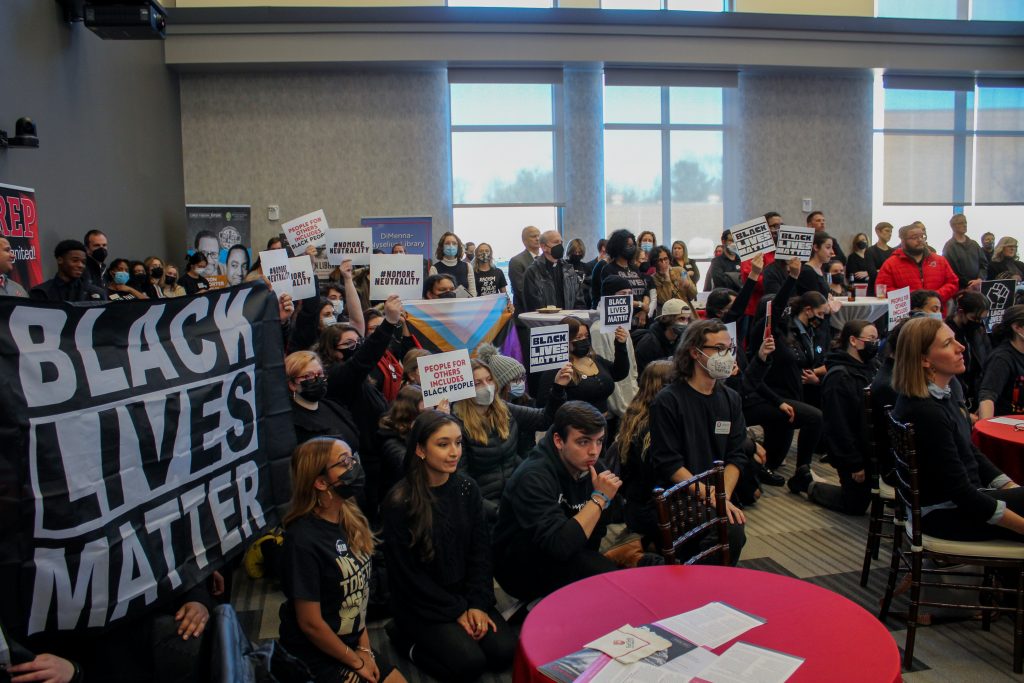
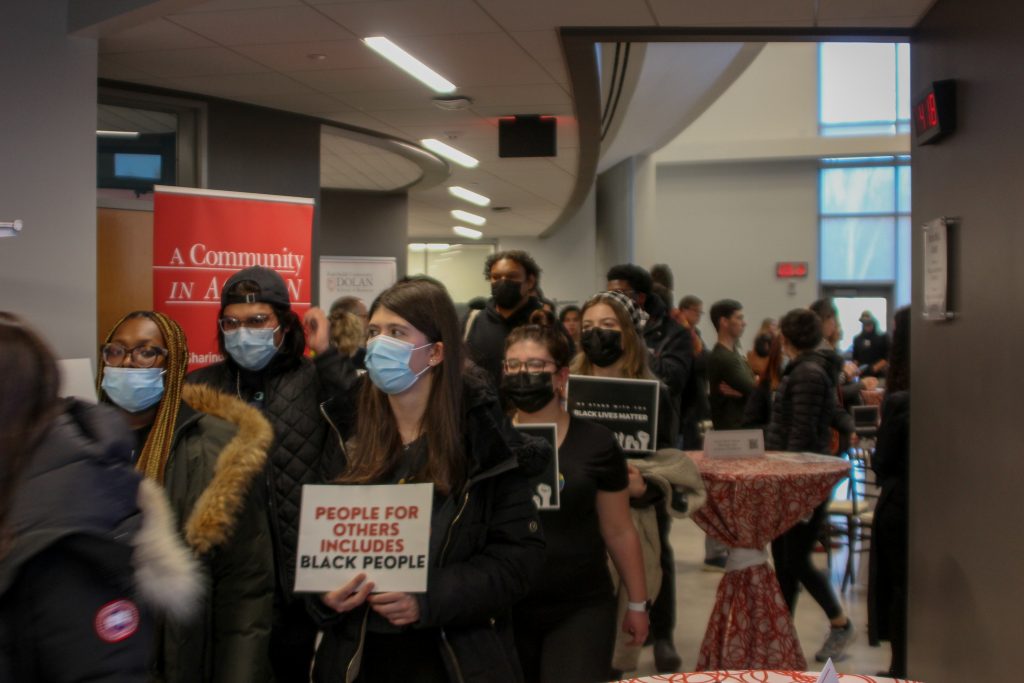

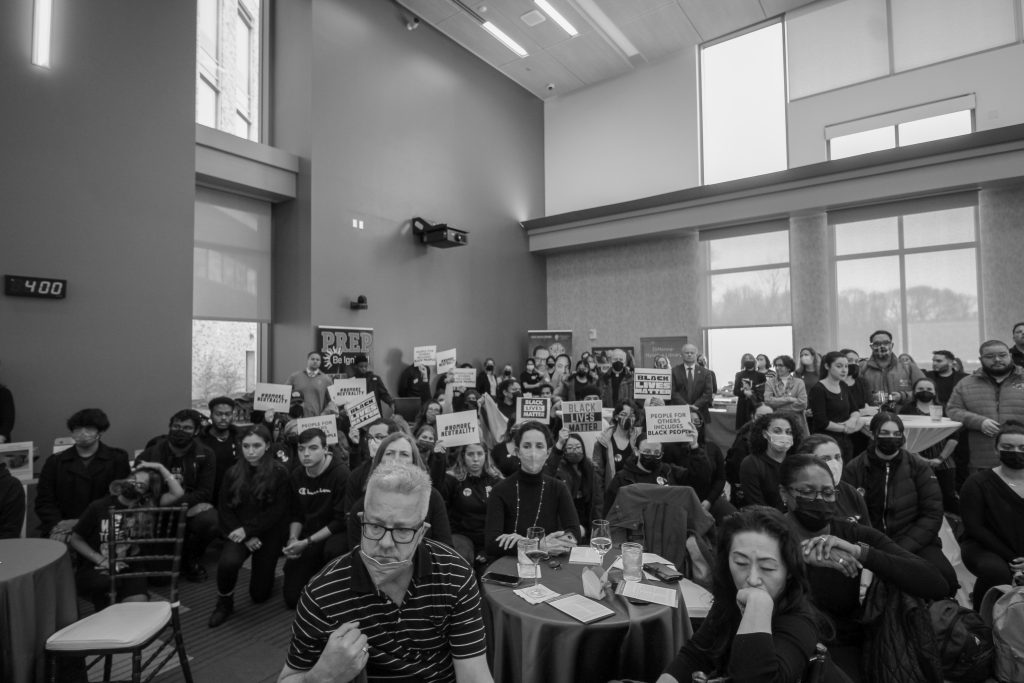

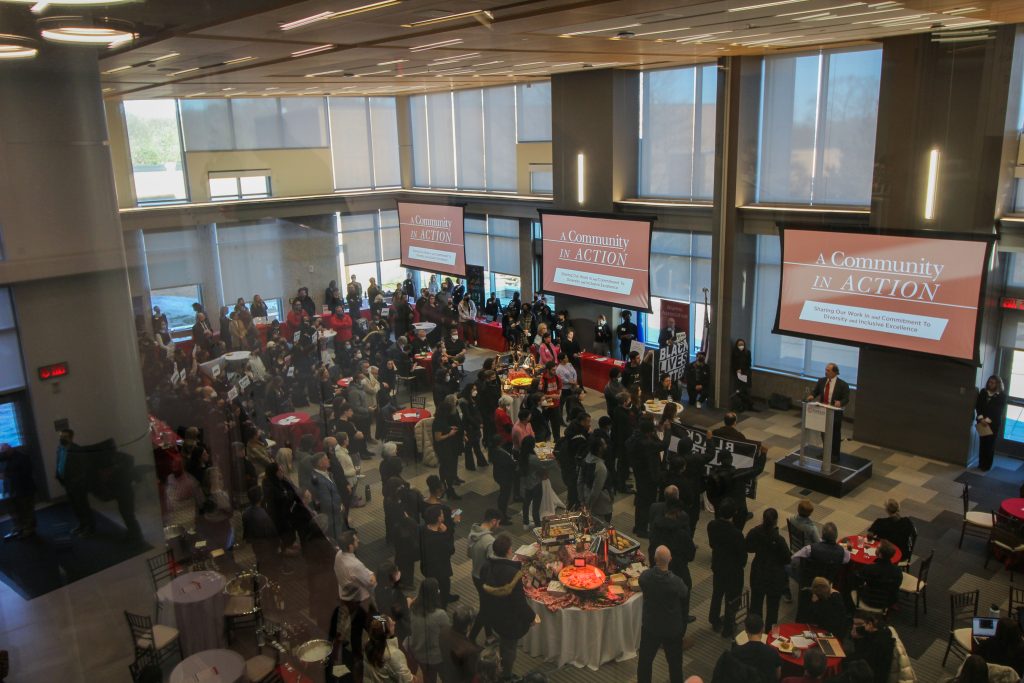
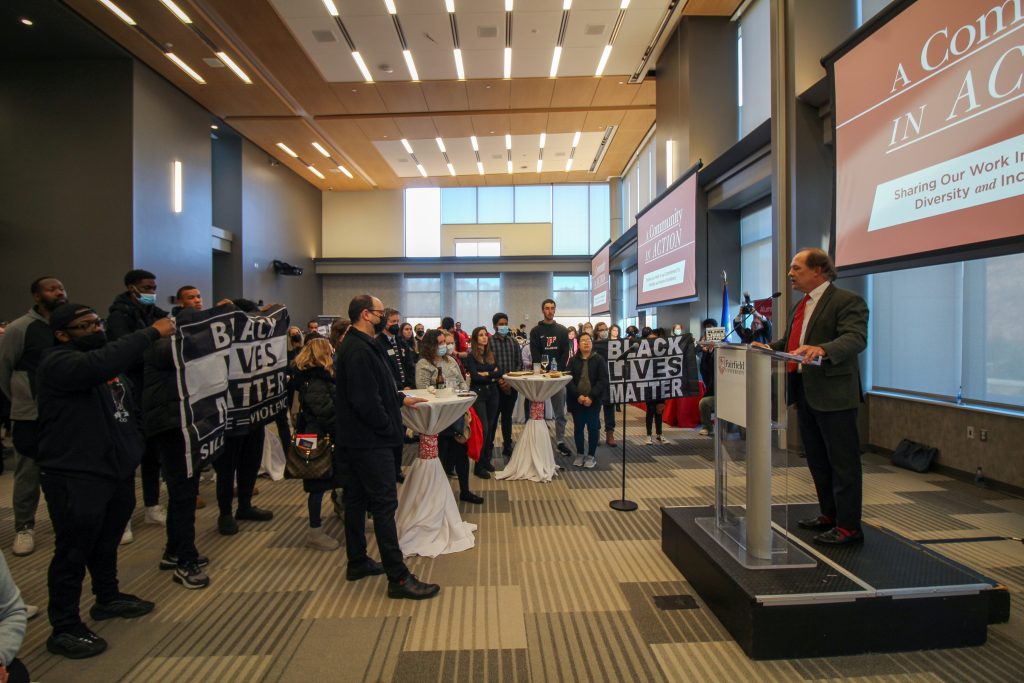
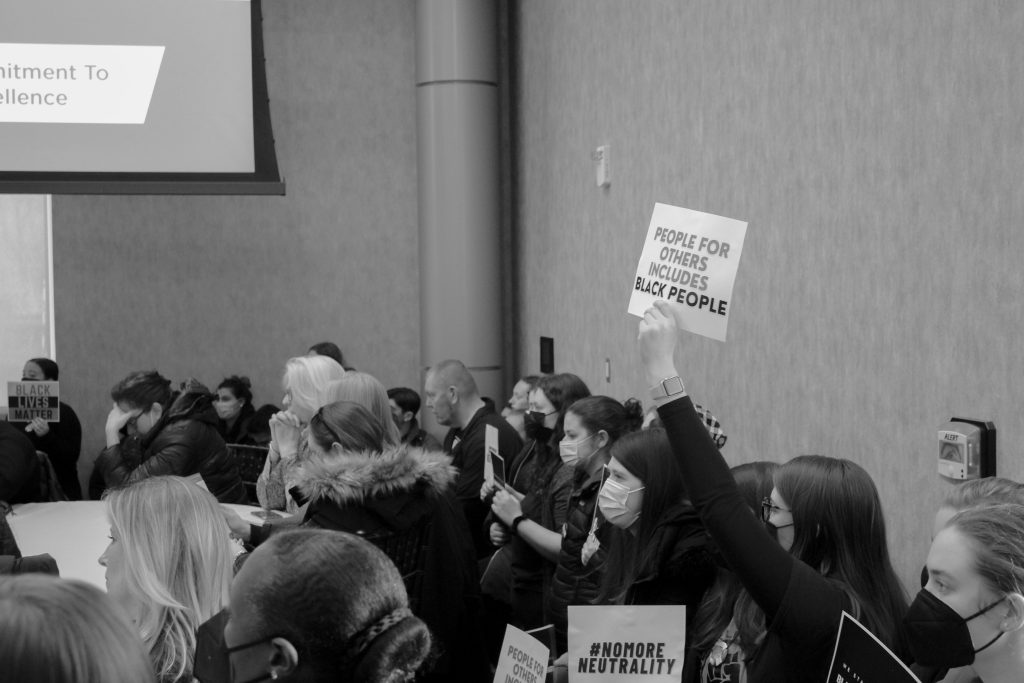

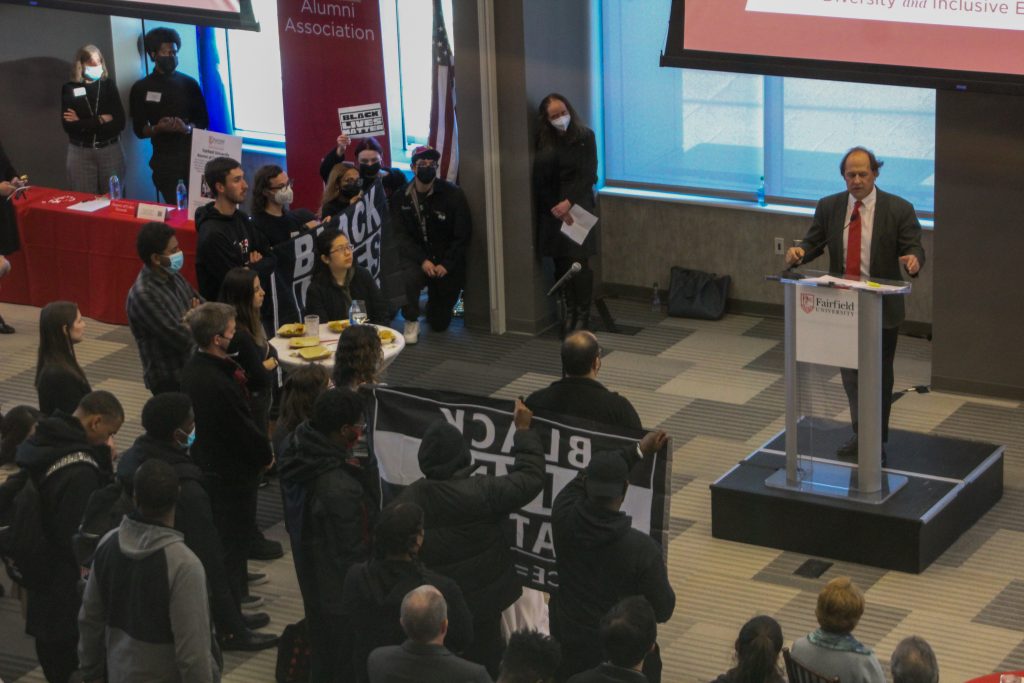
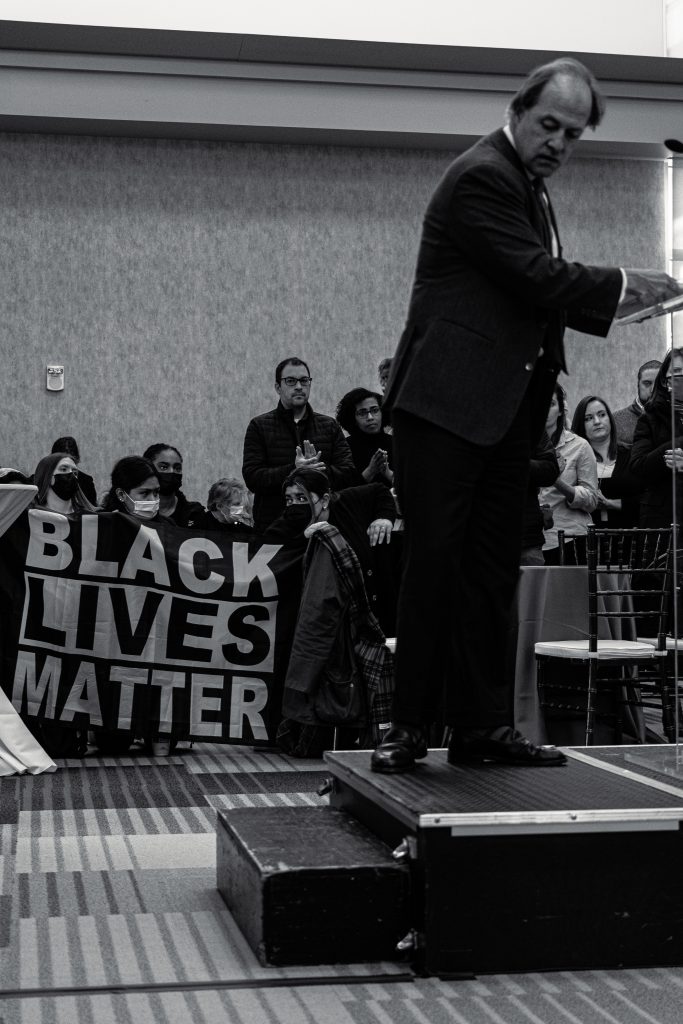


Leave a Reply